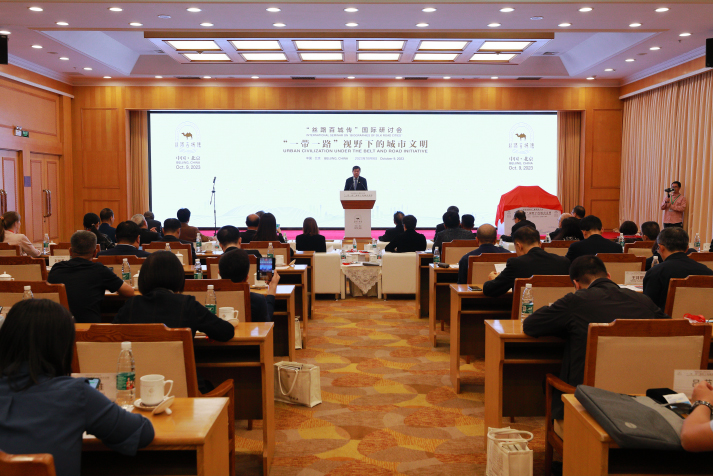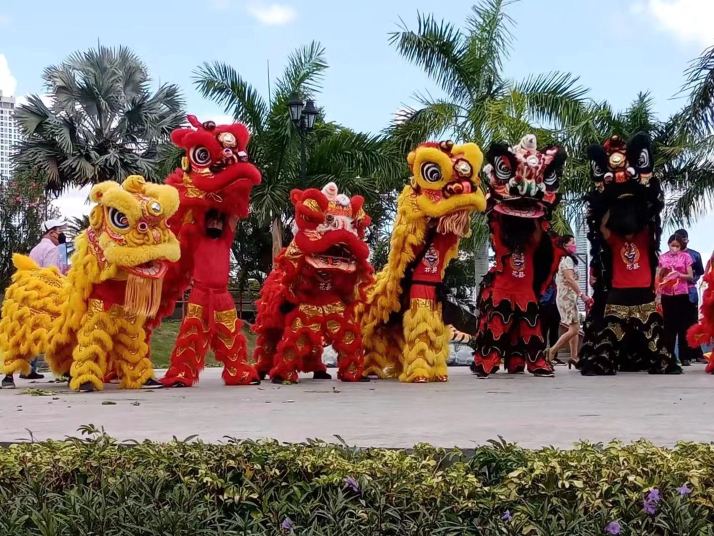Book series explores the past, present and future of cities along the ancient trade routes

The International Seminar on Biographies of Silk Road Cities is underway in Beijing on Oct. 9, 2023. [Courtesy photo]
China and Panama are some 15,000 km apart, equal to a little more than one third the circumference of the Earth. However, the close connection between these two countries stretches not only a vast geographical distance, but also a long way back in time. Friendship and bilateral exchange between them has been growing since Chinese people first set foot in the Central American country more than 160 years ago.
Since the two countries established diplomatic relations in June 2017, bilateral cooperation in trade, infrastructure and other fields, as well as people-to-people exchange, have advanced at an increased rate. China has been Panama's largest trading partner since 2019 and, at present, is the second largest user of the Panama Canal, after the United States.
Every year, a variety of events are held in Panama City, the nation's capital, to celebrate traditional Chinese holidays. They provide opportunities not only for Chinese people to celebrate their culture, but also for Panamanians to immerse themselves in and learn about the Chinese civilization.
In 2021, the Panamanian Government designated the Chinese New Year, also known as the Spring Festival, the most important traditional occasion for Chinese people that is celebrated somewhere between late January and mid-February, as a national holiday, integrating the celebrations of the festival into Panama's international tourism promotion plan.
However, there is still much room for the two peoples to learn more about each other. "Panamanians are generally unfamiliar with China, and there are few reports on China in the mainstream media of their country. In China, the case is almost the same," Yu Xi, a Chinese journalist who has been working to promote non-governmental exchanges between China and Latin American countries, said in his new book The Biography of Panama City, published in December 2022.
In addition to Panama City's history, architecture and landscape, the book expounds on the Central American country's development and its relations with China. Yu said he hopes that Chinese readers will better understand the city and the country through the book, which is his third work on Panama.
The Biography of Panama City is one book in the Biographies of Silk Road Cities series published by the New Star Press, an affiliate to China International Communications Group. To date, the series has covered more than 60 cities and is written in Chinese, Russian, Kazakh and Uzbek, with plans to include additional languages. The project aims to compile a collection of profiles on 100 cities located along the Silk Road.
The ancient Silk Road, dating back over two millennia, linked Asia, Europe and Africa with vibrant trade. Now, more countries, like Panama, are expanding cooperation under the framework of the China-proposed Belt and Road Initiative (BRI), which aims to boost connectivity along and beyond the ancient Silk Road routes.
The Silk Road was more than an ancient trading network for study by archaeologists and historians, but rather, an ever-evolving web of exchange among the countries along its routes, Liu Chuanming, deputy director of the editorial board of the book series, said at the International Seminar on Biographies of Silk Road Cities in Beijing on October 9.
"We hope the book series will highlight the unique history and characters of each city and provide a rich context for the BRI, thus contributing to cultural exchange and mutual learning among civilizations," the Publisher's Note reads.
Interaction, interconnection
Around 140 B.C., during China's Han Dynasty (206 B.C.-A.D. 220), Zhang Qian, a royal envoy, made a journey to Central Asia from Chang'an (present-day Xi'an in Shaanxi Province in northwest China) on a mission of peace, opening the Silk Road linking Asia and Europe. Centuries later, in the years of the Tang (618-907), Song (960-1279) and Yuan (1279-1368) dynasties, Silk Road routes boomed both over land and across the sea, facilitating trade between the countries they reached. In the early 15th century, Ming Dynasty (1368-1644) explorer Zheng He commanded a fleet on seven voyages that took him to Southeast Asia, South Asia and East Africa, which boosted trade between China and countries in those regions.
Ten years ago, Chinese President Xi Jinping proposed the BRI consisting of the Silk Road Economic Belt and the 21st-Century Maritime Silk Road, which draws inspiration from the ancient Silk Road.
By June this year, China had signed more than 200 BRI cooperation agreements with more than 150 countries, including Panama, and more than 30 international organizations across five continents, yielding a number of signature projects and small-scale yet impactful projects, according to a white paper titled The Belt and Road Initiative: A Key Pillar of the Global Community of Shared Future released by China's State Council Information Office in October.
Through the Biographies of Silk Road Cities series, readers can discover more of these cities in their past and present, their vicissitudes, local customs and cultures, their people's joys and sorrows, as well as their charms and enduring elegance, Liu said.
Biographies of Silk Road Cities is an international platform showcasing the cities' history and culture, and for writers and scholars to conduct in-depth exchange, directly promoting friendly relations among countries and regions, Jian Yining, editor of the book series, told Beijing Review.
Previously, books on cities in China were more like historical records, while city biographies can be written from different angles and with different forms of expression, Wei Yushan, Director of the Chinese Academy of Press and Publication, said at the seminar.
"The book series not only provides fresh material for people today to understand the development of the cities along the Silk Road routes, but also serves as a mini-encyclopedia to help future generations understand the civilizations they represent," Wei added.

A lion dance performance at an activity celebrating Chinese New Year in Panama. [Courtesy photo]
Lively cities
"As a Hangzhou native, I am more than willing to introduce this city," Wang Xufeng, author of The Biography of Hangzhou, told the seminar. "Hangzhou has seen great changes in recent years, but at the same time, its distinctive characteristics have preserved."
Hangzhou, capital of Zhejiang Province in east China, had been a major silk producer in China for centuries and the Longjing green tea produced in the city is considered to be among the finest nationwide. It was a major hub on the Silk Road routes in ancient times and its foreign trade in silk, tea, porcelain and other commodities dates back thousands of years. Now, it is famous for its burgeoning e-commerce sector. It has also hosted international events including the recent 19th Asian Games and the 2016 Group of 20 Summit.
For Wang, Hangzhou is the land of attractions and the countless celebrated people who were born or lived in the city for a long time, including poets, writers, philosophers, statesmen and business leaders, demonstrate the city is praiseworthy not only as a place of gorgeous landscapes but also one of great minds.
Hangzhou's people are known for being artistic and diligent, as the city has nurtured many great masters in historical study, literature and landscape design. "They are serious about eating, drinking and being merry—idling away their time in pleasure-seeking," Wang said. "This is returning to the very essence of life."
Similar to Hangzhou, Samarkand in Uzbekistan is also a city where great scientists, poets and thinkers gather. "Great scientific discoveries and immortal literary, artistic and folk handicraft works continue to emerge in this land. Grand palaces and mosques, along with supporting facilities, have also been built here," President of Uzbekistan Shavkat Mirziyoyev wrote in the preface of The Biography of Samarkand.
Once a major hub on the Silk Road, Samarkand is the intersection of diverse cultures and trade between East and West. Recently, a Silk Road international tourist center near Samarkand has been inaugurated, attracting domestic and international travelers.
"I believe the publication of The Biography of Samarkand will help strengthen the relationship between Uzbekistan and China, develop cultural exchange between the two countries, and further bridge the gap between the two peoples," Mirziyoyev concluded.

